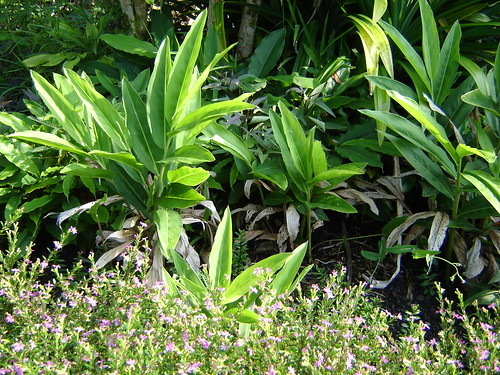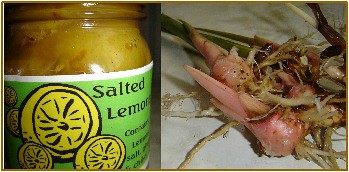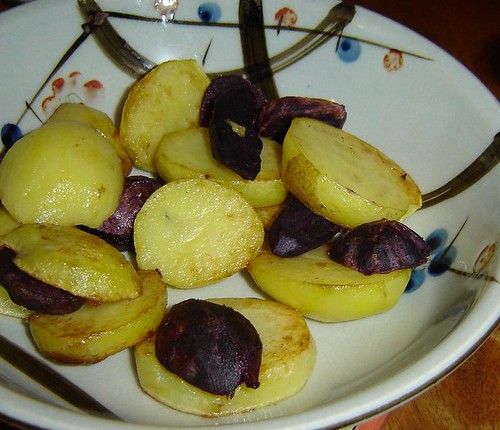
For this dish I used my Confit of Duck legs topped with a sauce of white wine, Kaffir lime zest and Galangal ginger - an important and popular ingredient in the foods of Indonesia and Southeast Asia, especially in Thailand. For those of you unfamiliar with this Asian spice, here is some history and benefits from a Thai cooking site I came across in my search for the best ways of preparing the fresh root. I wanted to concoct a pan sauce that would both counter and complement the rich, unctuousness of the duck. Something light and zippy.
History of Galangal
Galangal is now grown in most Southeast-Asian countries, but was first harvested for use in cooking and medicine in China and Java. But by the Middle Ages, galangal had traveled extensively, and was already in common use throughout Europe. Referred to as "the spice of life" by St. Hildegard of Bingen (1098-1179), galangal was, in fact, one of her favorite remedies. This famous herbalist used galangal to treat everything from deafness and heart disease to indigestion.
During the 13th-14th centuries, galangal was used by the Turkic peoples (who occupied much of present-day Russia) as a tea, and by the Arabs as a stimulant for their horses. It was used extensively throughout the East as a snuff for nasal infections, and in both Europe and Asia as an appetite stimulant and aphrodisiac.
Today, galangal is still in use in Russia, where it is used to make vinegars as well as liqueurs. It also has a thriving market in India, where it is not only valued as a spice but also as a perfume to make deodorants. Presently galangal remains, however, most commonly used in Southeast-Asian countries like Thailand, where the spice is not only a medicine, but has become part of the daily diet-which tells you how healthy Thai cuisine really is!

So, enough about that particular ingredient. I love it though, and am cultivating even more to supply my habit, since it does so well in Hawaii. Here's my little bed of galangal, behind the Mexican Heather.

Another ingredient from our garden is the lemon factor, both in my Lemon Mead and Preserved Lemons. You can see the gnarly galangal roots here. The Kaffir lime used for its zest is also home grown.
Confit of Duck, is an incredibly delicious and succulent preparation involving a salt cure, then slow cooking submerged in duck fat. Though if you are in a hurry, it can be bought prepared. Or if the duck fat puts you off, you can use olive oil. I like to buy a whole duck, break it down, render the fat and use that. Aside from making confit with the giblets and legs, it's great for frying up potatoes, as I did for this meal.

The duck is preserved beneath a lovely blanket of duck fat, 3 weeks in the fridge, then brought to room temperature (so the tender meat won't pull off when you remove it).
Duck Confit with White Wine Reduction
This dish was partly inspired by Mario Batali's recipe for Duck with Preserved Lemons and Kumquat Vinaigrette from his book, The Babbo Cookbook.Serves 2
2 confit of duck legs
1 tablespoon duck fat, grapeseed oil or olive oil
1/2 onion
3/4 cup duck or chicken stock
3/4 cup dry white wine (I used my lemon mead)
2 tablespoons galangal ginger, finely minced and pounded in mortar or food processor
1/2 teaspoon kaffir lime zest
1 tablespoons honey (taste, you may want more)
salt and white pepper to taste
for garnish - 1 preserved lemon quarter - skin only, rinsed and sliced thinly
Preheat oven to 350F
First, remove your duck legs (brought to room temp.) from the fat, and wipe down excess with a paper towel. In an ovenproof saute pan, heat the tablespoon of duck fat or grapeseed oil (does well at high temperatures) over high heat until smoking. Add duck legs and saute them, skin side down, until the skin is crispy. Remove pan from the heat and place it in the oven to heat through, for about 5 minutes. Plate and set aside, covered with foil, to keep warm.
In the same pan, saute the onion, until translucent and turning golden brown, then add galangal, and saute a few more minutes, add stock and wine. Reduce by half the amount over medium-high heat. Lower the heat, and add your kaffir lime zest and honey. Simmer gently about 5 minutes.
Pour over the duck and garnish with preserved lemon slivers. Serve with a salad of mixed greens (Ruhlman suggests a salad of arugula, red onions and and cerignola olives). I used arugula from our garden, some romaine lettuce and red onion macerated in Sherry vinegar. Amazing served with potatoes pan-fried in duck fat. Soooo good. I added in a few little sweet potatoes from my garden too. Nice with a glass of dry Lemon Mead.

So, all in all, this meal used a number of items home grown, and I'll be sending it along to enter in the May Grow Your Own event, hosted this time by The Daily Tiffin.
As a short addendum, there was just enough sauce and duck left to have over pasta for my lunch next day. Topping with a bit of parsley was a good flavor and color note. I'd add it to the main dish next time.


7 comments:
i love the picture of the duck in the duck fat. i am very curious about the galangal flavor in all this. i totally wish we could grow that here... ahhh to live in hawaii!
You are a very talented lady!
Ginger would work also, just that bit of aromatic zest, together with a zap of citrus, to accent the succulent duck.
Thanks Sunny.
Fan-tabulous meal!
Are those Okinawan sweet potatoes!
They're the common, local, purple variety. The leaves are purple too, and make a nice ground cover under my bananas.
love the galangal pic. It hasnt come back in my pot this year, but the neighbours one which was int eh ground has come back.
This is a lovely dish. Your garden is so full of delicious things! Where were are galangal and kaffir lime leaves can only be found in the Asian grocery stores. We're planning a trip back to Hawaii next year and can't wait to visit the farmer's markets again. Thanks
Post a Comment